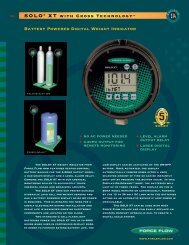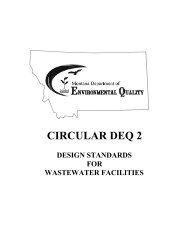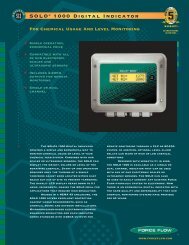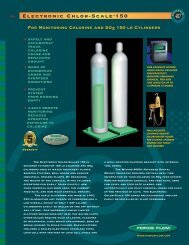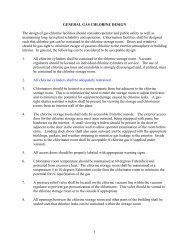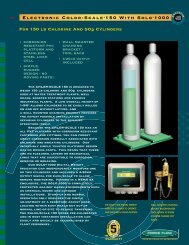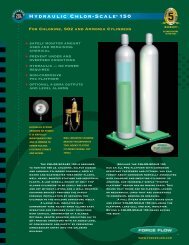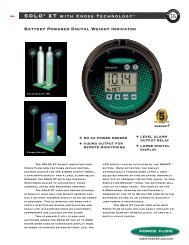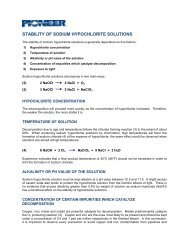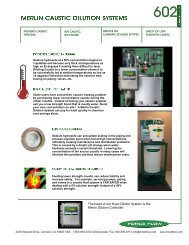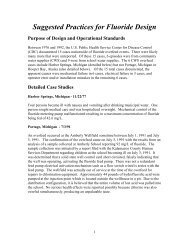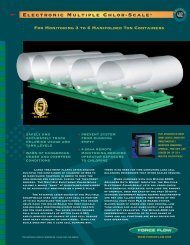Sodium Hypochlorite Handbook - Force Flow
Sodium Hypochlorite Handbook - Force Flow
Sodium Hypochlorite Handbook - Force Flow
Create successful ePaper yourself
Turn your PDF publications into a flip-book with our unique Google optimized e-Paper software.
4.4 PumpsThe choice of pumps for sodium hypochlorite depending on the application can be separated intocentrifugal and positive displacement such as diaphragm. In all applications, the only metal acceptableis titanium. However, many non-metallic pumps can be used with or without the structural metal orFRP component.One of the best centrifugal pumps for sodium hypochlorite is a titanium pump. However, these pumpsare expensive compared to other choices and the design cannot avoid the use of seals. There aremany good seals available for these pumps and the purchaser should refer to the manufacturer fordetailed recommendation. However, any good seal will only last typically 3-5 years and will requirereplacement. Since good seals are expensive, depending on the application a less expensive magneticdrive pump can be used and even though the pump will not last as long, total cost of operation will beless than a titanium pump.Therefore, for centrifugal applications, the best choice of pump may be a lined steel magnetic drivepump. Linings of Teflon®, Tefzel® and other non-metallic materials are used. These pumps may onlylast from 3-7 years but depending on the pump, 2 or 3 pumps with spare parts can be purchased for thesame cost as a titanium pump. If a magnetic drive pump is used, a power monitor must be used toprevent dry running of the pump and damage to the shaft and bearings.There are many choices of diaphragm pumps for small flow applications. Many choices for the pumphousings are available and successful. The diaphragms can be of Teflon® or some rubbercompounds. However, if rubber compounds are used, Viton® is the preferred choice. EPDM issuccessful but may not have as long as service life as Viton®.There are other types of pumps available and they may be used for special applications. Pump choicesshould be made based on manufacturer’s recommendations and customer satisfaction.4.5 Piping4.5.1 PVCTypical choice for low-pressure piping is PVC Schedule 80 socket welded pipe and fittings. Do not usethreaded joints for sodium hypochlorite connections if possible. Over time, a threaded joint will have atendency to leak and threading the pipe reduces it structural integrity.PVC piping should not be used for high pressure, typically over 50 to 60 pounds since failures result inpotential injury. If higher pressures are used with PVC, use soft start motors on pumps and slowopening and closing valves if automated valves are used to start and stop flows. Velocities in PVCsodium hypochlorite piping systems should not exceed 7 feet/second and better results will be achievedif the velocities are kept less than 5 feet/second. Care must be taken to use an industrial grade cleanerand glue for the PVC and to follow the manufacturer’s installation instructions. PVC installed outsidemust have UV protection.4.5.2 Lined PipeFor high pressure or very long service life, a lined piping system typically of Teflon® is used includingcarefully designed expansion joints. Linings are usually PTFE and fittings and pipe are a 150# flangeddesign. These systems are expensive but can result in 20-30 year service life. Other liners can beused such as Kynar, Tefzel, and Halar but based on cost and service life and successful applicationsPTFE appears to be the best choice.4.5.3 Titanium PipeLightweight schedule 5 and 10 titanium pipe can be used for very long runs for sodium hypochlorite.These are welded systems with carefully designed expansion joints. In some larger piping systems,titanium can be a cost effective method of piping compared to a lined pipe system and betterperformance can be achieved since most flanged joints are avoided.



